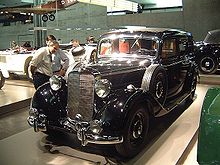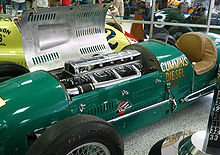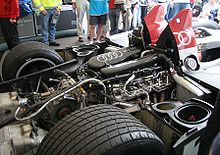- History of the diesel car
-
Production diesel car history started in 1933 [1][2] with the Citroën Rosalie, which featured a diesel engine option (the 1766 cc 11UD engine) in the Familiale (estate or station wagon) model.[3] The Mercedes-Benz 260D and the Hanomag Rekord were introduced in 1936.
Immediately after World War II, and throughout the 1950s and 1960s, diesel-powered cars began to gain limited popularity, particularly for commercial applications, such as ambulances, taxis, and station wagons used for delivery work. Most were conventional in design. Mercedes-Benz offered a continuous stream of diesel-powered taxis, beginning in 1949 with their 170D powered by the OM-636 engine. Later, in 1959 their OM-621 engine was introduced in the 180D This 2.0L engine produced 55 hp (41 kW) at 4350 rpm. Beginning in 1959, Peugeot offered the 403D with their TMD-85 four-cylinder engine of 1.8L and 48 hp (36 kW), followed in 1962 by the 404D with the same engine. In 1964, the 404D became available with the improved XD88 four-cylinder engine of 2.0L and 60 hp (45 kW). Other cars available with diesel power during this era included the Austin A60 Cambridge, Isuzu Bellel, Fiat 1400-A, Standard Vanguard, Borgward Hansa, and a few others.
In 1967, Peugeot introduced the world's first compact, high-speed diesel car, the Peugeot 204BD. Its 1.3L XL4D engine produced 46 horsepower (34 kW) at 5,000 rpm. Following the 1970s oil crisis (1973 and 1979) , Volkswagen introduced their first diesel, the VW Golf, with a 1.5L naturally aspirated IDI[disambiguation needed
 ] engine. This was a redesigned (dieselised) version of a petrol engine. Mercedes-Benz tested turbodiesels in cars tested (e. g. by the Mercedes-Benz C111 experimental and record-setting vehicles). The first production turbo diesel cars were, in 1978, the 3.0 5-cylinder 115 hp (86 kW) Mercedes 300 SD, available only in North America, and the Peugeot 604.
] engine. This was a redesigned (dieselised) version of a petrol engine. Mercedes-Benz tested turbodiesels in cars tested (e. g. by the Mercedes-Benz C111 experimental and record-setting vehicles). The first production turbo diesel cars were, in 1978, the 3.0 5-cylinder 115 hp (86 kW) Mercedes 300 SD, available only in North America, and the Peugeot 604.The biggest single step forward for mass-market diesel cars came in 1982 when PSA Peugeot Citroën introduced the XUD engine in the Peugeot 305, Peugeot 205 and Talbot Horizon. This was the class leading automotive diesel engine until the mid 1990s.[4] The first mass market turbo diesel was the XUD powered, 1988 Citroën BX and then the 1989 Peugeot 405, they gave power and refinement approaching petrol engine standards,[5] with the best chassis in their class. Diesel Car magazine said of the Citroën BX "We can think of no other car currently on sale in the UK that comes anywhere near approaching the BX Turbo's combination of performance, accommodation and economy".[6] These were the cars that started the diesel boom in Europe that has now hit 50% of the market in new car sales.[citation needed]
Many Audi enthusiasts claim that the Audi 100 TDI was the first turbo charged direct injection diesel sold in 1989, but actually it isn't true, as the Fiat Croma TD-i.d. was sold with turbo direct injection in 1986[7] and two years later Austin Rover Montego.[8] What was pioneering about the Audi 100, however, was the use of electronic control of the engine, as the Fiat and Austin had purely mechanically controlled injection.[citation needed] The electronic control of direct injection really made a difference in terms of emissions, refinement and power. All earlier generation car direct injection diesel engines benefit greatly from the use of biodiesel fuel, which reduces emissions and greatly improves refinement without engine modifications, provided they use compatible 'Viton' type rubber in their fuel systems.
The diesel car markets are the same ones who pioneered various developments (Mercedes-Benz, BMW, Peugeot/Citroën, Fiat, Alfa Romeo, Volkswagen Group), with the exception of Austin Rover, although Austin Rover's ancestor, the Rover Company had been building small-capacity diesel engines since 1956, when it introduced a 2051 cc 4-cylinder diesel engine for its Land Rover 4 × 4. In fact, the 1988 Austin-Rover MDi unit (also known as the 'Perkins Prima') was developed by Perkins Engines of Peterborough, who have designed and built high-speed diesels since the 1930s. It is still in production as a marine engine.
In 1997, the first common rail diesel passenger car was introduced, the Alfa Romeo 156.[9]
In 1998, for the very first time in the history of racing, in the legendary 24 Hours Nürburgring race, a diesel-powered car was the overall winner: the BMW works team 320d, a BMW E36 fitted with modern high-pressure diesel injection technology from Robert Bosch GmbH. The low fuel consumption and long range, allowing 4 hours of racing at once, made it a winner, as comparable petrol-powered cars spent more time refueling.
In Spring 2005, Mercedes-Benz unveiled the first application of a mass-produced aluminum block diesel engine for passenger vehicles and commercial use. While aluminum is traditionally considered of inferior strength and temperature resistance to withstand diesel applications, Mercedes engineers made extensive use of CAD/CAM design to arrive at an aluminum block that would meet with Mercedes' rigorous testing and reliability standards. First use was in 2006 model-year vehicles in the E-Class sedan and ML-class and GL-class SUVs. Similar in weight (208 kilograms (460 lb)) to the five-cylinder it replaced, and considerably lighter than the in-line six cylinder it also replaced, this 3.0L V-6 produces 165 kW (224 hp) at 3,800 rpm and max torque of 510 Nm (376 ft·lbf) at 1,600-2,800 rpm and makes use of a four-valve head. Additionally, fitment of Mercedes-Benz BlueTec system, a concert of emissions control strategies, renders this new diesel 50-state legal in the U.S. beginning in 2008 (stringent NOx limits have made U.S. passenger-car diesels unpopular or impossible in parts of the U.S. in recent years).
In 2006, the new Audi R10 TDI LMP1 entered by Joest Racing became the first diesel-engined car to win the 24 Hours of Le Mans. The winning car also bettered the post-1990 course configuration lap record by 1, at 380 laps. However, this fell short of the all-time distance record set in 1971 by over 200 kilometres (120 mi).
The Subaru car company of Japan is preparing to sell its station wagon version of their Legacy mid-size car (called the Subaru Outback in North America) with a 2.0 liter, boxer engine format opposed-four cylinder diesel engine of 110 kW (150 PS; 148 hp) power, and 350 N·m (260 lb·ft) of torque, in the United Kingdom. Sales in continental Europe started in 2008, and in the United States by 2010.
Today the cars that produce the lowest CO2/km in emissions, lower than hybrids, are the most advanced compact European diesel cars.
Automobile racing
Although the weight and lower output of a diesel engine tend to keep them away from automotive racing applications, there are many diesels being raced in classes that call for them, mainly in truck racing and tractor pulling, as well in types of racing where these drawbacks are less severe, such as land speed record racing or endurance racing. Even diesel engined dragsters exist, despite the diesel's drawbacks of weight and low peak rpm, specifications central to performance in this sport. However, in 2006, the new Audi R10 TDI LMP1 entered by Joest Racing became the first diesel-engined car to win the 24 Hours of Le Mans.[10]
Historic
As early as 1931, Clessie Cummins installed his diesel in the Cummins "Diesel Special" race car, hitting 162 km/h (101 mph) at Daytona and 138 km/h (86 mph) at the Indianapolis 500 race,[11] where Dave Evans became the first driver to complete the Indianapolis 500 without making a single pit stop, completing the full distance on the lead lap and finishing 13th, relying on torque and fuel efficiency to overcome weight and low peak power.[12]
In 1933, a 1925 Bentley with a Gardner 4LW engine was the first diesel-engine car to take part in the Monte Carlo Rally when it was driven by Lord Howard de Clifford. It was the leading British car and finished fifth overall.[13]
In 1952, Fred Agabashian in a Cummins diesel won the pole at the Indianapolis 500 race with a turbocharged 6.6 liter diesel car,[14] setting a record for pole position lap speed, 222.108 km/h (138.012 mph).[12] Don Cummins and his chief engineer Neve Reiners recognized that the low center of gravity of the flat engine configuration (designed to lie beneath the floor of a bus) plus the power advantage gained by the novel use of Elliott turbocharging would be a winning combination.[15]
At the start, a slow pace lap (reportedly less than 80 km/h (50 mph)) apparently induced what is now referred to as "turbo lag" and badly hampered the throttle response of the Cummins Diesel. Although Agabashian found himself in eighth place before reaching the first turn, he moved up to fifth in a few laps and was running competitively (albeit well back in the field after a tire change) until the badly situated air intake of the car swallowed enough debris from the track to disable the turbocharger at lap 71; he finished 27th.[16]
Modern
When turbocharged diesel technology made progress in the 1990s and rule makers supported the concept, BMW and Volkswagen raced diesel touring cars, with BMW winning the 1998 24 Hours Nürburgring with a 320d against other factory-entered diesel competition of VW and about 200 normally powered cars, mainly by being able to drive very long stints. Alfa Romeo even organized a racing series with their Alfa Romeo 147 1.9 JTD models.
In 2006, a BMW 120d repeated a similar result, scoring 5th in a field of 220 cars, many of them much more powerful, a significantly stronger competition than in 1998. The VW Dakar Rally race Touareg for 2005 and 2006 are powered by their own line of TDI engines in order to challenge for the first overall diesel win there.
Meanwhile, the five time 24 Hours of Le Mans winner Audi R8 race car was replaced by the Audi R10 TDI in 2006, which is powered by a 650 hp (485 kW) and 1,100 N·m (810 lb·ft) V12 TDI common rail diesel engine, mated to a 5-speed gearbox, instead of the 6 used in the R8, to handle the extra torque produced. The gearbox is considered the main problem, as earlier attempts by others failed due to the lack of suitable transmissions that could stand the torque long enough.
After winning the 12 Hours of Sebring in 2006 with their diesel-powered R10 TDI, Audi obtained the overall win at the 2006 24 Hours of Le Mans, too. This is the first time a sports car could compete for overall victories with diesel fuel against cars powered with regular fuel or methanol and bio-ethanol. However, the significance of this is slightly lessened by the fact that the ACO/ALMS race rules encourage the use of alternative fuels such as diesel.
Audi again triumphed at Sebring in 2007. It had both a speed and fuel economy advantage over the entire field including the Porsche RS Spyders, gasoline powered purpose-built race cars. Audi's diesels won again the 2007 24 Hours of Le Mans, against competition coming from the Peugeot 908 HDi FAP diesel powered racer.
In 2006, the JCB Dieselmax broke the diesel land speed record posting an average speed of over 328 mph (528 km/h). The vehicle used "two diesel engines that have a combined total of 1,500 horsepower (1120 kilowatts). Each is a 4-cylinder, 4.4-liter engine used commercially in a backhoe loader." [17][18]
In the 2008 BTCC (British Touring car Championship), Jason Plato and Darren Turner are racing factory sponsored SEAT Leon TDI with some success against a variety of gasoline powered competitors.[19]
See also
- Diesel cycle
- Forced induction
- Indirect injection
- Diesel engine
- Turbocharger
- Dieselisation
- Diesel generator
- Gasoline direct injection
- Hybrid power source
- Junkers Jumo 205—The more successful of the first series of production diesel aircraft engines.
- Napier Deltic—a high-speed, lightweight diesel engine used in fast naval craft and some railway locomotives.
- Petrol engine , gasoline Ame
- SVO—Straight Vegetable Oil—alternative fuel for diesel engines.
- Wärtsilä-Sulzer RTA96-C—world's most powerful, most efficient and largest diesel engine.
- WVO—Waste Vegetable Oil—filtered, alternative fuel for diesel engines.
- History of the internal combustion engine
- Hesselman engine
References
- ^ "Citroen's Rosalie becomes the world's first commercially available diesel engined passenger car". http://www.nu-car.com/Diesel_Buyers_Guide/Diesel_Timeline.aspx.
- ^ "The world's first mass produced diesel car". http://www.oldengine.org/members/diesel/Misc/Ricardo.htm.
- ^ "Cats Citroën Net History". Cats-citroen.net. 1934-05-03. http://www.cats-citroen.net/citroen/history.html#UA. Retrieved 2010-11-20.
- ^ "Diesel Car" (Future Publishing Limited, July edition, 1993), p.104
- ^ "Diesel Car" (Future Publishing Limited, August/September edition, 1998), p.19
- ^ "Diesel Car" (Future Publishing Limited, August/September edition, 1998), p.22
- ^ "Turin will host GM's diesel center.". britannica.com. http://www.britannica.com/eb/topic-609705/Turin. Retrieved 2008-04-08.
- ^ "Maestro/Montego". austin-rover.co.uk. http://www.austin-rover.co.uk/index.htm?lm10storyf.htm. Retrieved 2008-04-08.
- ^ "New Powertrain Technologies Conference". autonews.com. http://www.autonews.com/files/07_ane_ptc/speakers.html. Retrieved 2008-04-08.
- ^ "World's First 7-Second Diesel Dragster". Diesel World Magazine. January 2007. http://www.dieselworldmag.com/content/view/62/.
- ^ Martin Leduc. "The Diesel engine and its development, A historical timeline". http://www.dieselduck.ca/library/other/prime_movers.htm.
- ^ a b Paul Abelson. "Track Star, The diesel-powered Audi R10 owns every race it enters". Road King Magazine. http://www.roadking.com/story.php?id=800.
- ^ "Firsts in sport". http://web.ukonline.co.uk/m.gratton/Sport.htm.
- ^ "Cummins History". Cummins. http://www.cummins.com/eu/pages/en/whoweare/cumminshistory.cfm.
- ^ Greg Littleton. "Snowberger's Done It Again — 1952 Cummins Diesel Car". National Indy 500 Collector Club. http://www.ni500cc.com/chutes/win05d.html.
- ^ Gavin Foster (2006-07-27). "Viva la diesel!". Mail & Guardian Online. http://www.mg.co.za/articlePage.aspx?articleid=278954&area=/wheels_deals/new_reviews/. (incorrect reference to the Cummins Diesel leading laps in the race)
- ^ Associated Press. "New diesel land speed record: 328 mph (528 km/h)". MSNBC. http://www.msnbc.msn.com/id/14486354/.
- ^ "JCB car beats diesel speed record". BBC. 2006-08-22. http://news.bbc.co.uk/1/hi/england/staffordshire/5273540.stm.
- ^ "SEAT Sport UK". SEAT Sport UK. http://www.seatsportuk.co.uk/sport/. Retrieved 2010-11-20.
External links
- "Diesel Engine In Racing Car Develops High Speed", May 193, Popular Mechanics history only known diesel race car
Categories:- Automobile history eras
- Automotive industry
- History of technology
Wikimedia Foundation. 2010.



